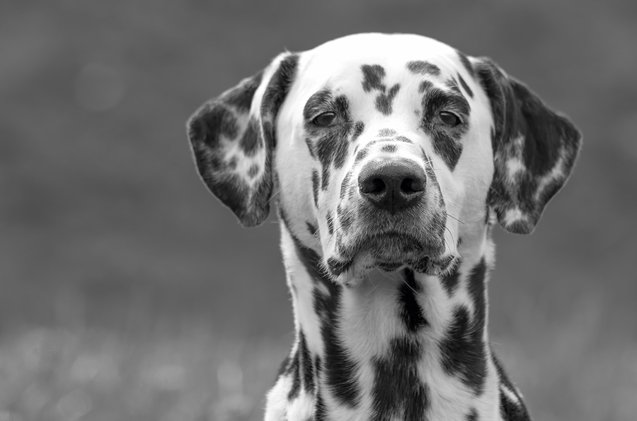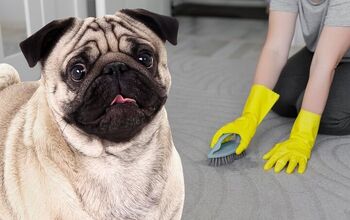Dalmador


About Dalmador
The Dalmador is a hybrid of the easy-going Labrador Retriever and the feisty Dalmatian, which makes him a perfect dog for an active family. His highly social nature means he loves kids, dogs, other pets and is comfortable around new faces. That said, he is a strong companion breed dog that feels protective of his human pack, so will bark to alert his owner if he feels it’s necessary.
The Dalmador is a hybrid of the easy-going Labrador Retriever and the feisty Dalmatian.
Dalmadors likely originate from the 1980s when mixing pure-bred dogs into hybrids first became popular. Although this makes him a relatively “young” dog in terms of heritage, his lineage certainly is not. The Labrador retriever first appeared in 19th century Newfoundland, Canada where he was used by fishermen to haul nets and pull in fish. The Dalmatian has come through the centuries without much change to his overall, spotted appearance. In fact, painted walls have been found in Egyptian tombs that show him running behind chariots!
Because he is considered a designer dog or hybrid, the Dalmador is not a member of the American Kennel Club’s (AKC). His parents however, have both achieved AKC status; the Labrador retriever was admitted to the club’s “sporting” group back in 1917 and is described as active, friendly and outgoing. The Dalmatian became a member of the “non-sporting” group in 1888 and is considered, dignified, outgoing and smart.
Because the Dalmador is considered a designer dog or hybrid, he is not a member of the American Kennel Club (AKC).
The Dalmador is a medium- to large-sized dog and needs a food specifically geared to his age and activity level. Kibble size should be large (to help prevent gobbling) and you can expect him to consume between 2.5 and 3.5 cups daily. Because Dalmatians tend to get urinary stones, constant fresh water is important for him. Food should always be top quality and indicate “meat” as a first ingredient and with hip dysplasia a concern from the Labrador side, foods that include glucosamine are a good option. Labradors tend to overeat so space his meals over two or more feedings and be sure to avoid fillers such as carbs and grains that will discourage him from over-eating to feel full.
The Dalmador is the hybrid of two very bright breeds that are often used as service dogs.
The Dalmador is the hybrid of two very bright breeds that are often used as service dogs. In spite of his intelligence, he can be a bit of a handful when it comes to training and like many dogs will need a consistent approach throughout his puppyhood – particularly when it comes to reigning in his tendency to bark or howl. Results will come, but they won’t be fast. As with all dog breeds, a positive, rewards-based approach to obedience and socialization training is best. Firm, consistent instructions accompanied by lots of praise and your choice of reward will result in a quick and successful training process.
The Dalmador is considered a medium- to large-sized breed and when fully grown, will weigh 50-80 pounds depending on gender.
The Dalmador is a friendly, trusting breed that is highly loyal to his pack and a great companion dog. He considers himself to be a key part of the family unit and loves to be included in all activities. Because Dalmatians were originally bred to be watchdogs, the Dalmador has a guarding instinct and can be quick to bark if he feels it is warranted but is not aggressive. The Lab side produces a friendly, cheerful personality that together with the alert Dalmatian produces a wonderful, intelligent dog that is easy to train and eager to please.
Hybrid dogs don’t necessarily experience the same health issues that plague their purebred parents but potential owners should take the time to research health concerns that may be passed down to their dog. Both Dalmatians and Labrador retrievers can suffer from hip and elbow dysplasia and Dalmatians can be prone to not only kidney stones and deafness, but have ranked 11th out of more than 3,000 dogs tested, for thyroid issues.
The Dalmador has a life expectancy of 10 to 14 years.
The Dalmador is an active dog who will need daily exercise to maintain his weight and keep him mentally and physically fit. His social nature means he will do well at a dog park or off-leash zone, but his tendency to become overly excited results in a pooch that should be monitored. He needs daily walks and fitness activities that include fetch or agility exercises.
The Dalmador is a friendly, trusting breed that is highly loyal to his pack and a great companion dog.
Also known as the Delmador or the Labradal Retriever, the Dalmador isn’t a member of the AKC however he is a member of the International Designer Canine Registry (IDCR), the American Canine Hybrid Club (ACHC), the Designer Breed Registry (DBR), the Designer Dogs Kennel Club (DDKC and the Dog Registry of America, Inc. (DRA).
The Dalmador will most certainly inherit some variation of the iconic spotted coat associated with Dalmatians. It may be pronounced and highly visible or subtle with just a smattering of lighter dots on dark fur. His short, dense, water-proof double-coat means he is a fairly heavy shedder and will require regular brushing – more frequently during spring and fall shedding seasons. Professional grooming is not necessary and bathing can be done on an “as needed” basis. Ears should be inspected and cleaned out weekly and his teeth brushed regularly.
Dalmador puppies should be tested for autoimmune thyroiditis which is common on the Dalmatian side of this dog. Additionally, a hearing test called a BAER can be conducted on puppies as young as five weeks that will identify whether he has inherited the Dalmatians propensity for deafness. Remember this pup comes from a line of dogs with joint issues so be careful not to overexert him and cause injuries that may be with him for life.
Photo credit: Bilevich Olga/Bigstock; Life on White/Bigstock; Ralli/Bigstock

Sharing space with three seriously judgy Schnoodles and a feline who prefers to be left alone. #LivingMyBestLife
More by Mary Simpson

























